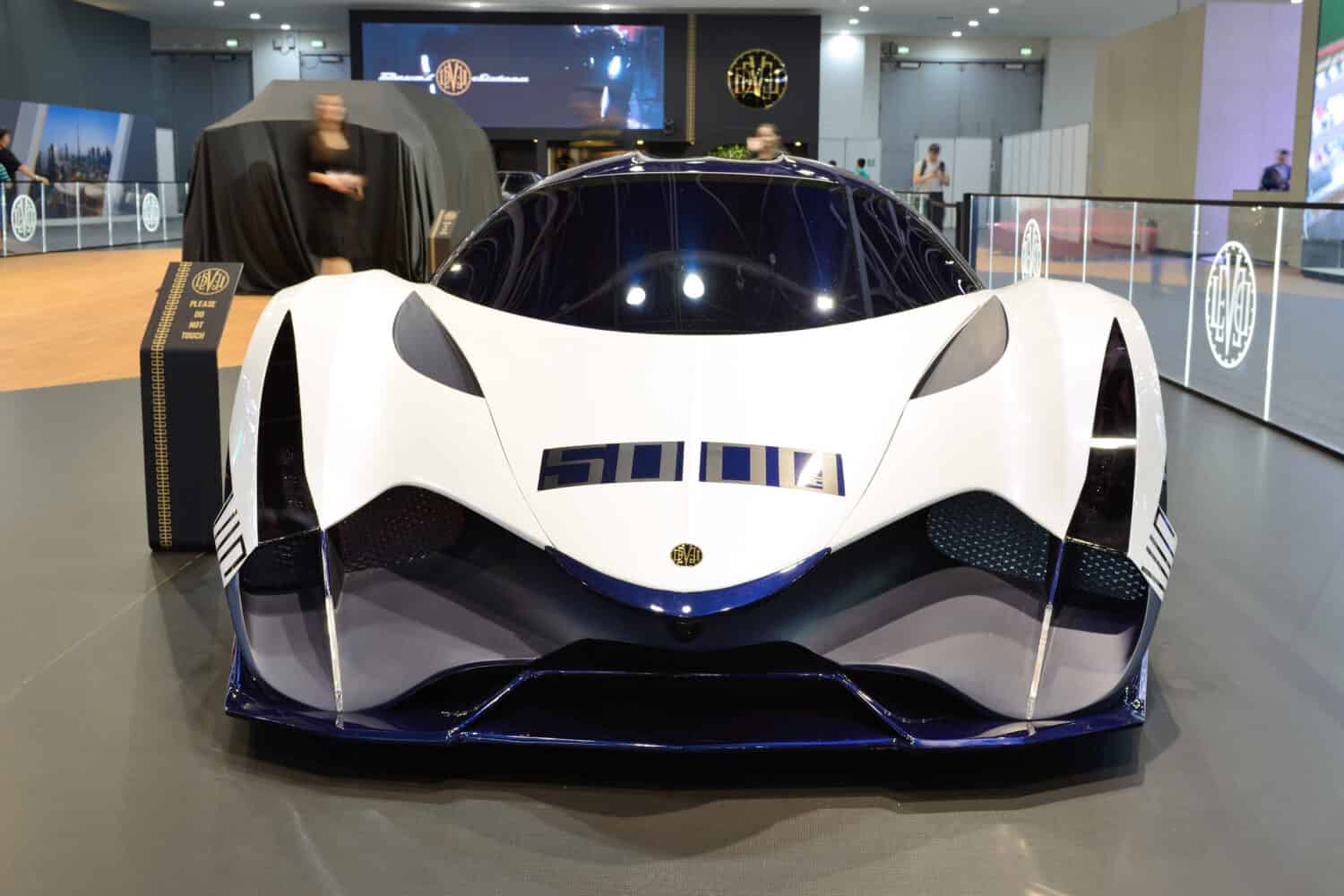Welcome to our blog post on “What is Horsepower, and How Much Does a Horse Have?” In this article, we will explore the origins of horsepower as a unit of measurement and how it applies to both machines and living creatures. Often used in discussions about cars, engines, and other machinery, horsepower has its roots in the world of horses. But just how much power does a horse actually have? Join us as we delve into the fascinating history and science behind this ubiquitous term.
What is Horsepower?

One horse generates between 5-10 horsepower on average.
©Sylvie Bouchard/Shutterstock.com
Horsepower is a unit of measurement for power, which is the rate at which work is done. It was first introduced in the late 18th century by Scottish engineer James Watt. He needed a way to compare the output of steam engines with that of horses, which were commonly used as a source of power at the time.
One horsepower is defined as the amount of power required to lift 550 pounds one foot in one second. This means that if you have an engine or motor with one horsepower, it can lift or move 550 pounds one foot in one second.
The concept of horsepower has since been applied to various types of machinery and vehicles, including cars and boats. It’s often used as a selling point for these products, with higher-horsepower models being marketed as more powerful and faster than their lower-horsepower counterparts.
Despite its name, however, horsepower doesn’t actually involve horses themselves – it’s simply named after them because they were once widely used as a measure of power before machines took over many tasks previously performed by animals.
How Much Horsepower Does One Horse Have?

Horsepower refers to machine power, not the power of animals.
©Jack R Perry Photography/Shutterstock.com
When it comes to understanding horsepower, many people may assume that the term refers specifically to a horse’s physical abilities. However, as it turns out, this is not entirely accurate. While horses are indeed capable of impressive feats of strength and speed, the concept of horsepower actually originated from the world of machines rather than animals.
In terms of how much power a single horse can generate, there are many factors at play. For example, breed, age, size, and health all play important roles in determining a horse’s overall strength and stamina. In general, though, one might expect a typical horse to produce somewhere between 5-10 horsepower on average.
Of course, as with any living creature or machine for that matter, there will always be outliers who are capable of more impressive feats. Some particularly strong or well-trained horses may be able to produce up to 15 horsepower in certain situations.
How Much Horsepower Does a Human Have?

Humans generate between .33 and 1 horsepower on average.
©FoodAndPhoto/Shutterstock.com
Unsurprisingly, humans are actually much less powerful than horses when it comes down to raw muscle output. In fact, the maximum power output for an average person is estimated at around just one-third of a single horsepower! Some very strong people can generate one horsepower.
Overall then – while “horsepower” may seem like an odd unit of measurement at first glance (especially given its origins), there is no denying that it has become an incredibly useful shorthand for describing how much work various machines are capable of.
How Is Horsepower Measured?
When it comes to measuring horsepower, there are two main units of measurement: mechanical horsepower and metric horsepower. Mechanical horsepower is the traditional unit used in the United States and is based on the work of James Watt, who developed the concept of horsepower in 1782. One mechanical horsepower equals 550 foot pounds per second or approximately 745.7 watts.
On the other hand, metric horsepower is a newer unit that was adopted by many European countries and Japan after World War II. Metric horsepower is defined as exactly 75 kilogram-force meters per second (or about 735.5 watts).
Both types of measurements are used today for various purposes, such as calculating engine power output in cars or determining how much energy a motor can produce for industrial applications. However, due to differences between units and conversion factors, it’s important to know which type of measurement you’re using when comparing different engines or motors.
Overall, understanding how to measure and compare different levels of horsepower can help individuals make informed decisions regarding their machinery choices while also providing valuable information for engineers working on developing new technologies with higher efficiency rates.
What Machine Has the Highest Horsepower?
The Wärtsilä RT-flex96C engine is a true marvel of engineering. This behemoth machine, which stands more than four stories tall and weighs an astonishing 2,300 tons, is capable of generating an astounding 107,389 horsepower and more than 7,000,000Nm of torque. To put that in perspective, this amount of power could easily run a small city.
What makes the RT-flex96C even more impressive is its use of common rail fuel injection technology to increase efficiency and reduce emissions. This two-stroke, low-speed diesel engine sets new standards for environmental performance in the maritime industry while still maintaining incredible levels of power.
In addition to its impressive output capabilities and eco-friendly features, the Wärtsilä RT-flex96C has other unique characteristics that set it apart from other engines on the market. With a redline of 102 RPMs – significantly higher than most similar engines – this powerhouse can generate enough torque to demolish a tank.
Despite its immense size and power capabilities, the Wärtsilä RT-flex96C engine serves practical purposes as well. It powers many cargo ships around the world, including the Emma Mærsk vessel, which transports over eleven thousand shipping containers at speeds up to thirty-one knots – much faster than other ships her size, allowing for reduced travel time and increased number of trips per year.
Overall this engine represents not only technological innovation but also economic benefits for ship owners seeking faster transportation with lower environmental impact through greener technologies.
What Production Car Has the Most Horsepower?

The Devel Sixteen has the most horsepower of any production vehicle.
©slava296/Shutterstock.com
Have you ever wondered what production car on earth has the most horsepower? Look no further than the Devel Sixteen, a stunning feat of engineering with an astonishing 5,007 horsepower. To put that into perspective, that’s more than five times the amount of horsepower found in a Bugatti Veyron.
The engine behind this impressive power is a v-16 Quad Turbocharged engine, which produces an unparalleled level of force. However, such raw power comes at a high price: the base V8 version costs $1.6 million dollars, and the 16-cylinder version costs over $2 million dollars.
But for those who can afford it, they’ll be rewarded with a performance that’s equally as impressive as its price tag. The Devel Sixteen boasts a top speed of 364 miles per hour and can go from 0 to 60 miles per hour in just 1.6 seconds – making it one of the fastest cars on earth.
Designed by Devel Motors in the United Arab Emirates, this car is truly unique not only for its extreme levels of horsepower but also for its sleek design and unmatched performance capabilities. For anyone seeking to experience ultimate luxury and automotive excellence at its finest – look no further than the Devel Sixteen!
How Does Horsepower Affect Vehicle Acceleration?
When it comes to discussing cars and their performance, horsepower is a key factor that cannot be ignored. While it provides us with a general idea of how quickly a vehicle can reach certain speeds or cover distances like the quarter mile, there are various other factors that also play an important role in determining a car’s acceleration.
One crucial aspect is gear ratios, which affect the way power is transmitted from the engine to the wheels and ultimately impact acceleration. Similarly, transmission shift speed can either enhance or hinder straight-line performance depending on its efficiency. Torque, another term often discussed alongside horsepower, refers to the twisting force generated by an engine and impacts acceleration by providing a more low-end grunt.
Apart from these mechanical features of vehicles themselves, external factors such as weight and aerodynamics also have significant effects on acceleration. Heavier vehicles tend to accelerate slower than lighter ones due to greater mass requiring more energy for movement, while sleeker designs with better aerodynamic profiles allow for smoother airflow over them, resulting in less drag and, thus, higher speeds.
Finally, tire grip plays an essential role in determining how well a vehicle accelerates since it affects traction between the tires and road surface, impacting overall stability during acceleration.
Despite all this complex interplay between different elements affecting vehicle performance during straight-line motion, debates about whether horsepower or torque is superior remain unproductive as each serves its own unique function, making them both necessary components when characterizing an engine’s capabilities.
The photo featured at the top of this post is © Lukas Gojda/Shutterstock.com
Thank you for reading! Have some feedback for us? Contact the AZ Animals editorial team.






